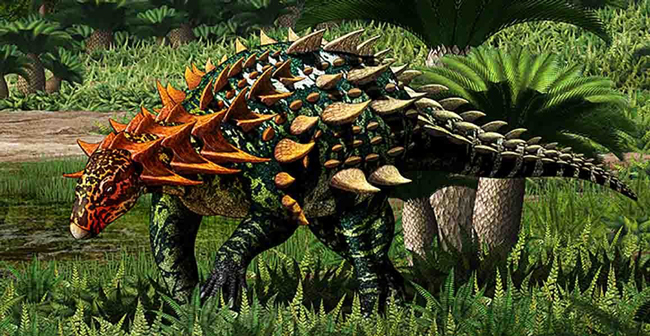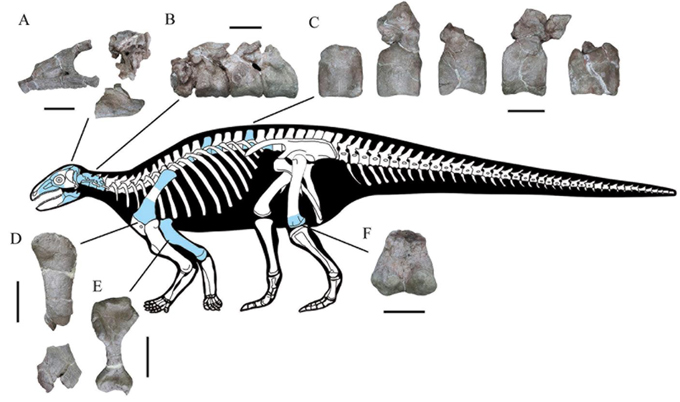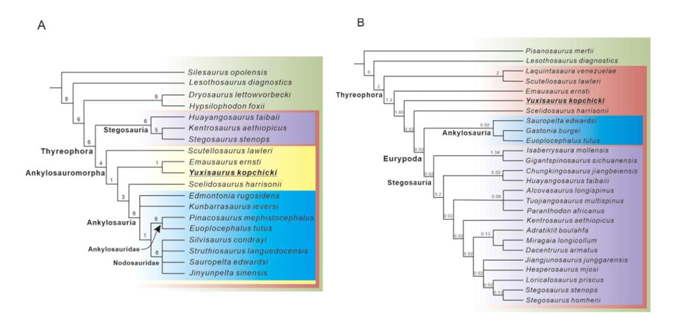The Earliest Armoured Dinosaur found in Asia to Date
Scientists including Professor Paul Barrett of the London Natural History Museum have described a new species of basal armoured dinosaur from fossils found in China. The dinosaur named Yuxisaurus kopchicki, represents the first valid and undisputed member of the Thyreophora (armoured dinosaurs) to be described from fossils found in Lower Jurassic Asian strata.

A life reconstruction of the newly described, Early Jurassic Chinese armoured dinosaur Yuxisaurus kopchicki. Picture credit: Yu Chen.
Picture credit: Yu Chen
The Rapid Geographic Spread of Early Armoured Dinosaurs
With an estimated body length of around three metres, Yuxisaurus might be small compared to some of the later and much more famous members of the Thyreophora clade such as Ankylosaurus and Stegosaurus, but confirmation of the presence of early armoured dinosaurs in China underlines the rapid geographic dispersal of these ornithischians. The first armoured dinosaurs are thought to have evolved around 200 million years ago (Hettangian faunal stage of the Early Jurassic). Yuxisaurus fossils consisting of vertebrae, skull bones, elements from the limbs, shoulder blades (scapulae) and 120 osteoderms (bony armour), were excavated from the upper portion of Fengjiahe Formation exposures, near Jiaojiadian village, Yimen County, Yuxi Prefecture, Yunnan Province (southwestern China).
Although the dating of the strata has proved problematical, it is likely that the fossils are somewhere between 192 and 182 million years old (late Sinemurian to early Toarcian stage of the Early Jurassic).
Variety Amongst Early Members of the Thyreophora
Although relatively small compared to later armoured dinosaurs, the limb bones suggest a robust, stout animal indicating that Yuxisaurus had a different body shape compared to other known early thyreophorans such as Scutellosaurus and Emausaurus. This suggests that early armoured dinosaurs had a diverse morphology and ecology and they spread rapidly establishing a wide geographical distribution and filling a variety of niches in Early Jurassic ecosystems.

Skeletal reconstruction of Y. kopchicki showing main preserved elements from the holotype (highlighted in blue). Details of the skull bones (A), cervical vertebrae (B) and dorsal vertebrae (C). The left scapula is shown (D) and the right humerus (E) along with the distal portion of the left femur (F). Note scale bars equal 5 cm for A-C and 10 cm for D-F. Osteoderms have been omitted to show the skeleton. Picture credit: Xi Yao.
Picture credit: Xi Yao
The First Unambiguous Armoured Dinosaur from the Early Jurassic of Asia
First author of the scientific paper, Professor Paul Barrett (Natural History Museum, London), commented:
“Although we’ve had tantalising fragments of early armoured dinosaurs from Asia, this is the first time we’ve had enough material to recognise a new species from the region and investigate its evolutionary history. I hope it’s the first of many new dinosaurs from the localities being discovered by my colleagues in Yunnan.”
Senior author of the paper, Dr Shundong Bi, a professor at Indiana University of Pennsylvania, explained that the dinosaur had been named Yuxisaurus kopchicki in honour of the Yuxi Prefecture, whilst the trivial or species name was in recognition of the work of molecular biologist Dr John J. Kopchick and for his support and funding of a new Indiana University of Pennsylvania science complex which is due to open in autumn 2023.
Dr Shundong Bi stated, that despite its robust body:
“Yuxisaurus was possibly a facultative quadrupedal. It was primarily adapted for walking on four legs, but also able to walk on two legs.”
Where Did Armoured Dinosaurs Originate?
Until recently all the unambiguous Early Jurassic Thyreophora taxa were described from fossils found in North America (Scutellosaurus) or Europe (Emausaurus and Scelidosaurus). This led palaeontologists to conclude that armoured dinosaurs originated in Laurasia, however, new phylogenetic analyses (Butler et al 2020, Boyd 2015, Raven and Maidment 2017, Maidment et al 2020 and Baron et al 2017a) have proposed that Lesothosaurus from southern Africa and Laquintasaura from Venezuela might also represent early members of the Thyreophora. If Lesothosaurus and Laquintasaura are early armoured dinosaurs, then this suggests that this clade could have originated in Gondwana.

Phylogenetic assessments plotting the relationship of Yuxisaurus within the Thyreophora. Analysis (A) modified from Norman (2021) dataset which places Yuxisaurus as a sister taxon to Emausaurus which is known from the Early Jurassic (Toarcian) of Germany. Analysis (B) modified from Maidment et al (2020) places Yuxisaurus within the Thyreophora as an early-diverging branch between Emausaurus and Scelidosaurus which is known from the older sedimentary deposits from Charmouth on the Dorset coast. Picture credit: Yao et al.
Picture credit: Xi Yao et al
The phylogeny of early ornithischians remains disputed, it is hoped that further fossil finds will resolve this debate.
Everything Dinosaur acknowledges the assistance of a media release from the London Natural History Museum in the compilation of this article.
To read an article about the discovery of Laquintasaura: Laquintasaura What Does it All Mean?
The scientific paper: “A new early-branching armoured dinosaur from the Lower Jurassic of southwestern China” by Xi Yao, Paul M. Barrett, Lei Yang, Xing Xu and Shundong Bi preprint via bioRxiv before publication in eLife.
Visit the award-winning Everything Dinosaur website: Dinosaur Toys and Gifts.

